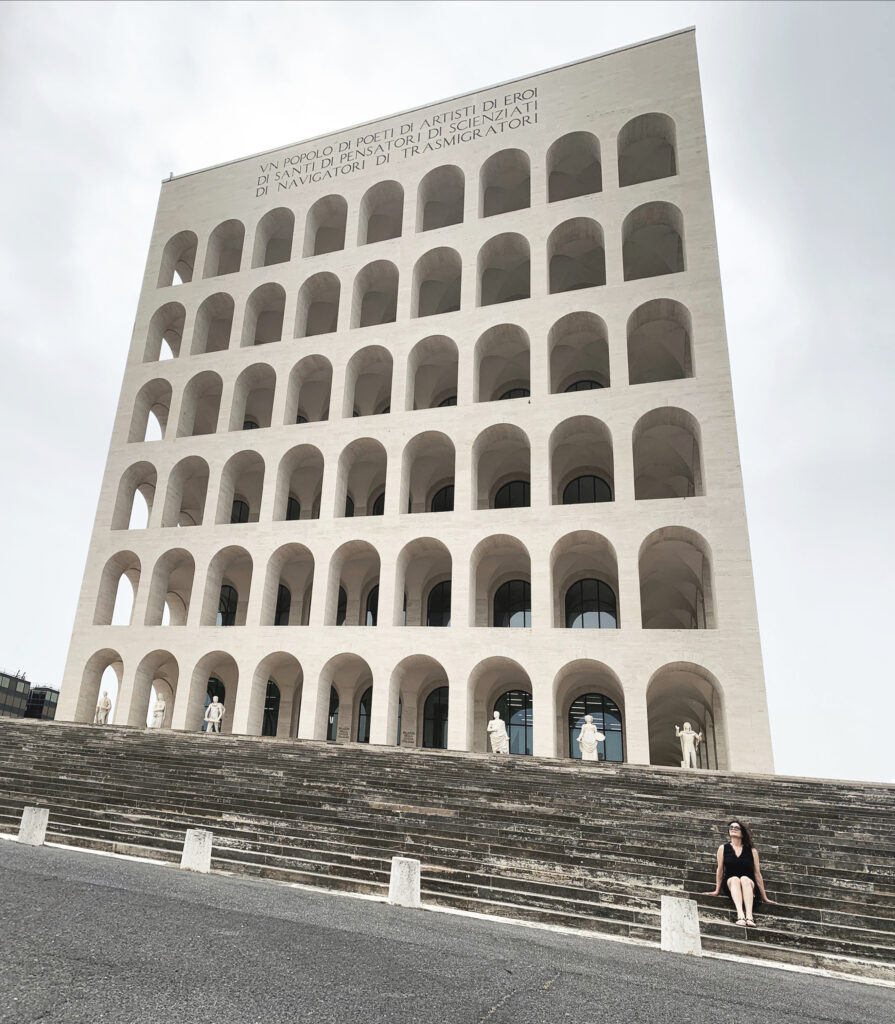
Along with its Colosseum, the legendary oval amphitheater and the largest to ever built in the ancient world, Rome has another colosseum, the so-called ‘Square Colosseum,’ the dream of every architecture admirer and the most substantial testimony to Benito Mussolini’s era. It is Rome’s best kept secret, but a must for anyone interested in modernism and in the links between architecture, politics, and society. That building is not only a breathtaking stylistic statement, but also a form shaped by the politics of its era, the focus of my visit this afternoon.
Mussolini knew the power of architecture to enhance and promote political power and thus, he initiated an ambitious building program, constructing some of the most memorable buildings of the 20s and 30s. This monumental and avant-garde architecture came to glorify his power and to express the particular Italian national identity of his regime. Known as Fascist Architecture, the idiom gained popularity with the rise of modernism in Germany and other places in Europe, but it had its own distinctive local character, relying on the buildings of ancient Rome. Whether stripped classicism or immaculate modernism, these structures came to be synonymous with Mussolini’s programs.
The most successful of all of his projects was certainly the EUR, and area built outside of Rome as a new monumental city that came to embody the new Imperial Rome and its leader. In 1937, Mussolini planted the cluster pine at the center of this future district and sought the best of Italy’s architects to create the new Roman, all of whom were committed fascists. He also chose this modernist area as the site for the International Exhibition of 1942 and was thus called E42, named after the year in which the exposition was to be open. This enormous area, south of Rome was filled with monumental and modernist structures, and therefore considered one of the most intriguing products of the Modern Movement in Italy. While the exhibition never took place due to WWII, this site has since come to symbolize Mussolini and his love for architecture. It is still capturing the imagination of architectural lovers and the memory of Romans of all generations.
The two most magnificent buildings were placed one across the other along a central axis. The first, Palazzo della Civiltà Italiana, also known as the ‘Square Colosseum,’ after the Flavian amphitheater, and across is the Palazzo dei Congressi by brilliant architect Adalberto Libera (below), both sit on the edge between modernism and neoclassicism, both innovative, powerful, and stunning.
Construction of the Palazzo della Civita Italians started in 1936. The fact that this white pristine building was the site of a tragic bloody clash between Italian soldiers and German paratroops, has left its mark on its legacy and particular on how Romans perceive the site: place of agony and tragedy. Its monumental appearance and neoclassical style was the product of two architects who won a public competition, La Padula, Guerrini and Romano. To Mussolini the Square Colosseum was to transmit strength and power, jusst as the Roman Colosseum used to refer to the Empire. The building is super photogenic, but more beautiful in person. It stands 63 meters high, for a total of seven floors, and the number of arches corresponded to the number of letters of the name and surname of Mussolini himself, a truly symbolic monument. It was a technological marvel, as it was constructed of reinforced concrete, then covered with white Roman travertine marble. Its inscribed in Latin: “One nation of poets, artists, heros, saints, thinkers, scientists, navigators and travellers”. My architecture pilgrimage.




Hi Daniella, how are you…?? Hope you are well and happy…!!
This post is very sentimental for me as I used to live in EUR many years ago when I was 21 years old and pass by and see this magnificent building a few times a day on my way to and from university…,it was a part of every day sights and life….I have the fondest memories of EUR and of beautiful Roma.
All the best.
Rachelli